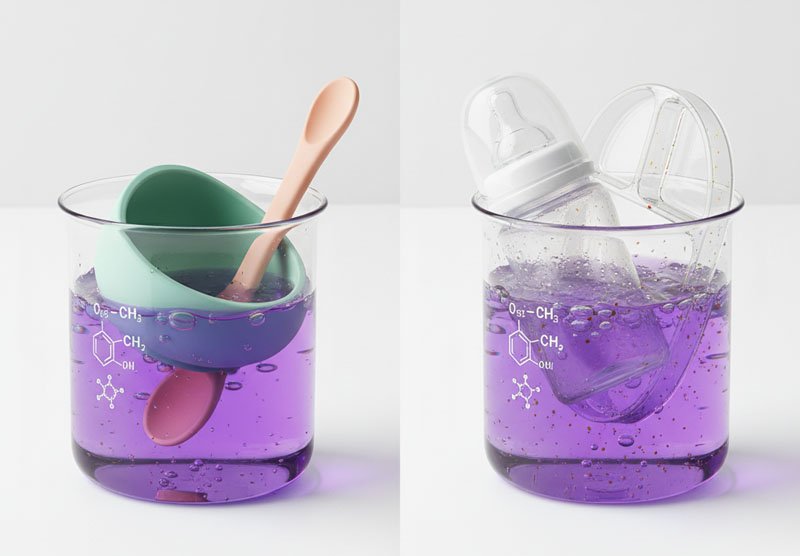“BPA-free” sounds safe—but is it really the best choice for babies?
Non-toxic silicone is safer, more stable, and longer-lasting than BPA-free plastic. While BPA-free plastic avoids one harmful chemical, silicone is inherently free from multiple toxins and resists heat, leaching, and degradation.
When choosing materials for baby products, the goal is clear: safety first. But with so many labels—BPA-free, phthalate-free, FDA-approved—it’s easy to get confused. Let’s break down what each term really means and why non-toxic silicone may be the better long-term choice.
What does “BPA-free plastic” actually mean?
BPA-free sounds like a win—but it only tells part of the story.
BPA-free plastic means the material doesn’t contain Bisphenol A, a chemical linked to hormone disruption. However, other harmful chemicals may still be present.

The Limits of “Free From” Labels
BPA (Bisphenol A) gained negative attention years ago due to its potential effects on brain development, hormones, and infant health. Manufacturers responded by introducing “BPA-free” plastics.
But here’s what I’ve learned from industry insiders and material testing:
- BPA-free doesn’t mean toxin-free.
- Some BPA replacements (like BPS, BPF) have similar risks.
- Most BPA-free plastics are still made from petroleum-based compounds.
- Heat can cause even BPA-free plastics to leach other chemicals.
In contrast, medical- and food-grade silicone is made from silica (a natural material from sand) and does not contain BPA, BPS, phthalates, or microplastic particles.
How do silicone and BPA-free plastic react to heat?
Baby products often need sterilizing, boiling, or microwaving—how well do these materials hold up?
Silicone withstands extreme heat without releasing toxins or losing shape. BPA-free plastic is less stable and may degrade or leach chemicals over time.

Safety in Sterilization
In my experience, the heat test is where silicone pulls ahead. Whether it’s baby bottles, spoons, or plates, items need to survive:
- Boiling water
- Steam sterilizers
- Dishwasher cycles
- Microwaves
Silicone easily handles temperatures up to 230°C (446°F). BPA-free plastic starts softening around 100°C (212°F) and can degrade with repeated exposure.
Here’s how they compare:
| Material | Heat Resistance | Leaching Risk | Microwave Safe |
|---|---|---|---|
| Non-Toxic Silicone | High | Very Low | Yes |
| BPA-Free Plastic | Moderate | Medium | Varies |
Heat stability isn’t just about durability. It’s about safety during cleaning, reheating, and everyday use.
Which material is more chemically stable?
The fewer unknowns in your material, the better.
Silicone is chemically inert, meaning it doesn’t react with food or break down into harmful compounds. BPA-free plastic may still contain reactive additives.

Stability = Peace of Mind
Silicone’s chemical structure gives it an edge in baby product safety. It doesn’t absorb food particles, release odors, or interact with other substances.
Plastics—even BPA-free ones—often include dyes, softeners, or stabilizers that aren’t always disclosed. Over time, these additives can degrade or migrate into food.
What I’ve seen in lab reports and customer feedback:
- Silicone maintains purity over years of use
- Plastic starts to look and smell different after a few months
- Parents report “plastic taste” after microwaving bottles or bowls
Silicone’s chemical stability offers peace of mind—especially for babies with allergies or sensitivities.
How do the materials perform in daily use?
Durability matters, especially for messy meals and daily routines.
Silicone is more durable, flexible, and long-lasting than plastic. BPA-free plastic is prone to cracking, discoloration, and damage from repeated cleaning.

Built to Handle Real Life
I’ve handled countless feeding sets, and plastic ones often show wear after just a few months. Cracked corners, cloudy discoloration, or melted edges are common.
Silicone is soft, but strong. It won’t crack when dropped, doesn’t discolor easily, and bounces back into shape—even after years of use.
| Feature | Non-Toxic Silicone | BPA-Free Plastic |
|---|---|---|
| Flexibility | Excellent | Low to Medium |
| Crack Resistance | Very High | Moderate |
| UV Stability | Strong | Weak (fades/yellows) |
| Dishwasher Durability | Excellent | Varies |
When you’re using products several times a day, durability becomes a core part of safety and value.
What about environmental impact?
Today’s parents care not just about safety—but about sustainability too.
Silicone is more sustainable due to its longevity and reusability. BPA-free plastic often ends up in landfills due to limited recycling options.

The Bigger Picture
Plastic waste is one of the biggest global problems. Even BPA-free plastic contributes to it. Most plastic baby products aren’t recyclable in local facilities.
Silicone isn’t biodegradable, but it’s far more reusable. One silicone spoon can last through multiple children or be repurposed for other uses. And some companies now offer recycling programs for silicone.
| Sustainability Factor | Silicone | BPA-Free Plastic |
|---|---|---|
| Reusability | High | Low |
| Average Lifespan | 2–5 years | 6–12 months |
| Recyclable (Special) | Yes | Rarely |
| Biodegradable | No | No |
In the long run, fewer replacements mean less waste—and that makes a big difference.
Which is the better choice for baby safety?
If you could only choose one for your child—what’s the safer bet?
Non-toxic silicone offers better overall safety due to its chemical stability, durability, and heat resistance. It’s the top choice for baby health and peace of mind.
Why I Always Recommend Silicone
When I work with baby product developers, our first goal is always child safety. Plastic—BPA-free or not—just doesn’t meet the same standard.
Here’s a summary of how both materials compare:
| Category | Non-Toxic Silicone | BPA-Free Plastic |
|---|---|---|
| Heat Resistance | ✅ Excellent | ⚠️ Moderate |
| Chemical Safety | ✅ Very High | ⚠️ Limited |
| Durability | ✅ Long-lasting | ⚠️ Short-term use |
| Environmental Impact | ✅ Reusable | ❌ Disposable |
Silicone costs a bit more upfront—but the benefits last much longer, for both your child and the planet.
Conclusion
Non-toxic silicone is the safer, longer-lasting, and more reliable choice compared to BPA-free plastic. When safety, durability, and sustainability matter, silicone leads the way.